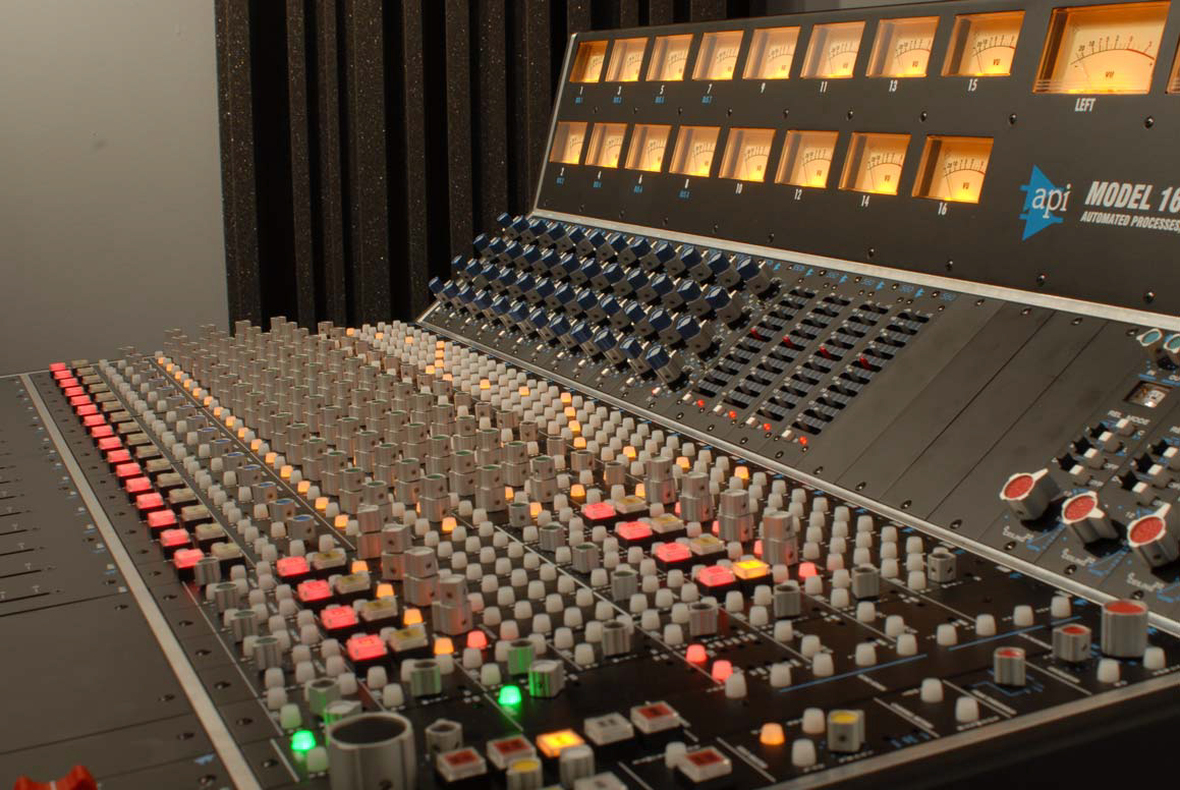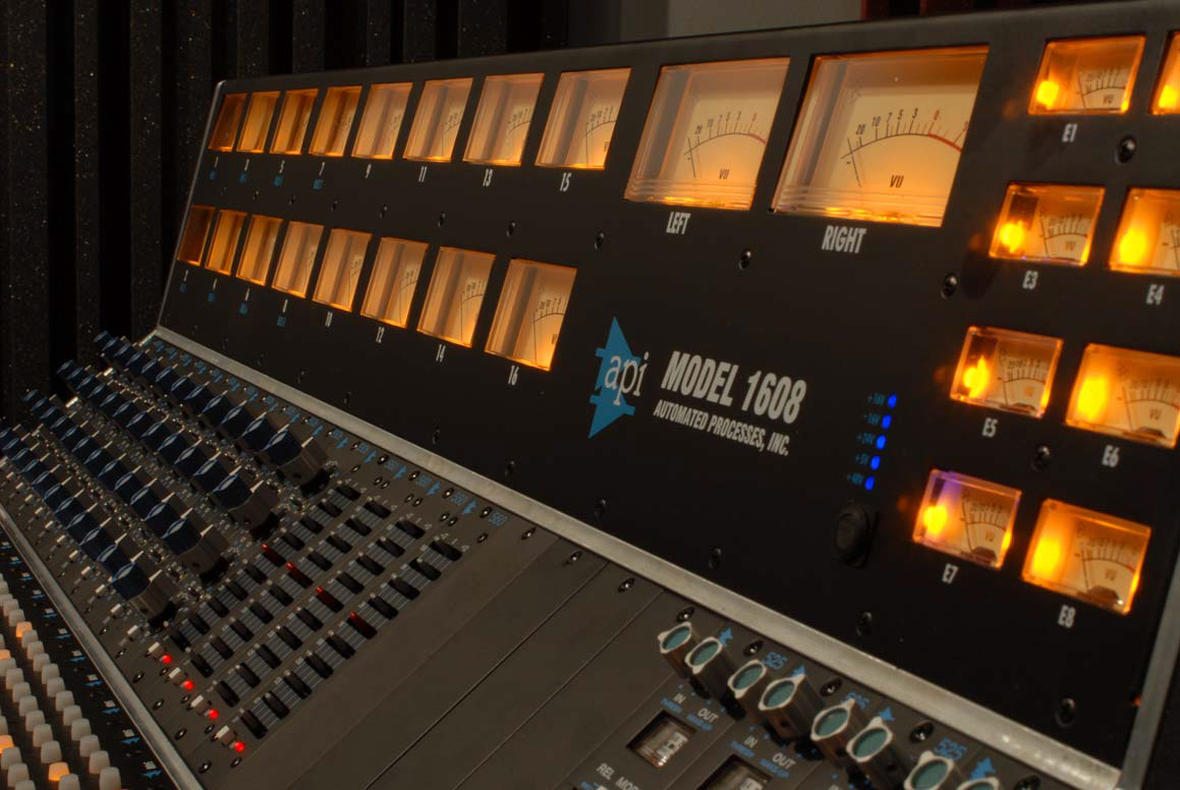
Review by George Shilling
The 1608 is a small format recording console based on the 1604 which API produced in the 1970s and early 1980s. Although I have never encountered one in the UK, examples in the USA are still cherished and lovingly restored.
Designed by Jeffrey Bork, the 1608 adds modern features including a few concessions to 5.1, but essentially this is a well-appointed 16:8:2 console, with the enormous attractions of 16 of API’s legendary mic preamps built in, and a 500-series slot per channel loaded with a classic EQ module. Additionally there are 8 Echo Returns with full routing, each with their own corresponding (and patchable) 500-Series slot – one can even load eight 512Cs for a full 24 mic preamps. All console buttons illuminate, and the master section is comprehensively featured. The rear panel is covered with clearly labelled connections – a substantial patchbay would be needed for all these. Topping it off is a beautiful VU-equipped meter bridge. Optional 16 channel expanders can be connected to provide up to 64 channels.
The fader board comprises two 8 fader units housing Alps 100mm faders which have a light touch, and a conventional fader top – no doubt cheaper and probably easier to use than the retro API type. There is blank space below the Sends/Returns sections (submaster trims are on little pots rather than faders) with a stereo master fader far right with unity at the top.

The 548B Input module sensibly employs large momentary illuminating Solo and Mute buttons above the fader. PFL, AFL (both with level trim) and SIP modes are available from the master section. Solo Safe is available per channel, and there is also a handy Mute Group operated from the master section. All switching seems to take place elegantly and crisply, and great care has been taken to ensure signal integrity, with no VCAs or FET switches anywhere.
Unusually (but sensibly) located near the bottom of the strip is the input section. The mic preamps are similar to the 212L type, as fitted to the Legacy Console, with separate (XLR) Line and Mic inputs, along with a jack Instrument input on the rear. However, jack insertion defeats the channel’s Mic input, so one will either need to permanently assign necessary channels for instrument or line use, or crawl around the rear of the console to plug as necessary! Gain for mic or Instrument is up to 55dB, but switching to Line defeats the gain knob The fixed line gain can be reduced by only 6dB using the Pad button, but on a mic signal the Pad is -20dB. Individual Polarity and Phantom switches are also available here, as befits a professional console.
Working upwards one next encounters Aux/Echo Sends. There are eight sends, with Pre-fade switching in pairs. 1-4 are arranged as two dual mono, with dual-concentric gain pots and individual On buttons, while 5-8 are arranged with similar knobs arranged as stereo level and pan, and a single On button per pair. So far, so sensible, but additionally Sends 7/8 are equipped with a To Subs button which allows you to additionally send some of the main signal to the first four of the eight routing busses via the channel routing buttons, pre or post fader. Signal is sent independently of the Send On/Off button, which is still in circuit with regard to the Send 7/8 outputs. Clever stuff, which still allows sending the main fader directly to busses 5-8 for supreme flexibility and 5.1 scenarios, for example.

Above the Sends is the routing section, dominated by the Panpot. This has a neat, tight, centre détente and is always in circuit to the main mix, which one selects by pressing the PGM (Program) button. The Pan button is only relevant when routing between odd and even bus assignment buttons at the top of the strip. A patchable Insert is also switchable here, it is post-EQ, but there is an additional pre-EQ non-switched insert point available on the rear of the console. All connections for inserts are on balanced jacks. There is also the added bonus of a High-Pass Filter, located on the channel output, -3dB at 50Hz and 6dB/octave – very useful.
As well as routing to PGM and the eight busses, the signal is also always present at a Direct Output, post-fader. I would have liked the option of pre-fade outs to enable recording and monitor mixing simultaneously, but that can be bodged if really necessary using the Insert point (although it would preclude use of the filter).
500 series slots are filled as standard with 12 reissue 550A three-band plus filter EQ modules. The remaining four channels are each equipped with the 560 10-Band Graphic. Both these legendary models employ the Proportional-Q characteristic, which narrows the filter at extreme settings, always seeming musical and rich, and preventing you doing anything nasty.
The Echo returns and master Sends modules are awash with buttons, (usefully illuminating but unfortunately all yellow) with myriad options. The Returns feature full level, panning and routing options, with large Solo and Mute buttons, and Solo Safe. As well as the main line level inputs (on a D-Sub) there are jack inputs which one can switch to by selecting Aux In. Additionally, the Sends can even blend another external input to their signals by connecting a jack source and pressing Ext In.
Simple Submaster controls for the eight busses allow for trimming (unity is at full-tilt on the knobs but these can be tweaked with a Cal pot), on/off, latching Solo and separate left and right program assign – again all buttons are yellow.
Separate Mutes and Cal pots are provided for each monitor of a 5.1 arrangement, and comprehensive switching is provided for two additional stereo monitoring setups. The three external inputs also all provide for 5.1, and stereo Echo Send monitoring enables checking of headphone mixes.
The main control room level is a stepped knob, but there is an accompanying continuous Dim control allowing for pretend fade-outs. Talkback is comprehensive with an inbuilt mic, and an Oscillator and a Headphone output add useful functionality. Meters can helpfully be set to show Preamp, Direct Out or Submaster out levels, while there are separate Send meters. And there is even a switchable Program Insert on the main stereo bus.
This console is exactly what a modern API should be. It is comprehensively featured, looks and feels great, and with regard to audio quality I trust no other manufacturer more than API.
Pros: Legendary API quality; comprehensive features for many scenarios including 5.1
Cons: More colour-coding of button LEDs would be useful; Panpot a long reach from fader
Reproduced with kind permission from www.georgeshilling.com. Copyright ©






